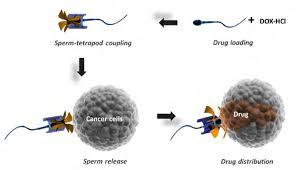Want something that moves like sperm and can help treat cancer? A research team at Hong Kong University of Science and Technology has engineered a one-step magnetic platform that mass-produces sperm-like “microrobots.” These tiny swimmers pack drug payloads and tackle tumors with pinpoint delivery. It’s a leap forward in precision therapy. (Science X via Medical Xpress; NCBI research roundup)
Swimming Ahead: What These Microrobots Do
These aren’t science-fiction bots. The HKUST team uses a Vortex Turbulence-Assisted Microfluidics (VTAM) method to create sperm-like microrobots in one smooth step, with magnetic control guiding them. They mimic natural sperm motility but tailored for drug delivery—navigating deep into tumors with efficiency natural swimmers can’t match.
In lab tests, the microrobots successfully delivered drugs to cancer-cell spheroids in vitro and even to live specimens like C. elegans. That’s big, because it demonstrates both targeting accuracy and real biological interaction. The technology could become a staple in minimally invasive procedures. (HKUST News via Science X)
Why It Matters to Medicine
Typical chemotherapy floods your system—side effects are common and sometimes life-threatening. These microrobots open a more surgical solution, delivering substances directly to where they’re needed. Imagine shrinking tumors without poisoning your gut, immune system, or hair follicles. It’s not just efficiency—it’s humane therapy.
Another win is scalability. Previous microrobot models often involved complex, multi-step production methods, keeping them stuck in the lab. HKUST’s one-step platform stands to make manufacturing easier, faster, and more cost-effective—making clinical adoption more realistic.
Next Steps: What Comes After Lab Success
These results are still early stage, but promising. The team plans to test in more complex animal models and monitor long-term safety. Key challenges include avoiding immune reaction, maintaining propulsion in fluid environments like blood, and ensuring microbot cleanup or safe biodegradation post-delivery.
The magnetic steering can also be enhanced. Experts suggest combining magnetic fields with imaging tech—like MRI—to track these bots in real time in humans, making sure drugs land precisely at the target spot without stray paths.
Broader Implications and Future Possibilities
Beyond cancer, these swimmers could deliver medication directly to other hard-to-reach areas—like the brain or inner eye—avoiding invasive procedures like injections or surgeries. They might also adapt to tasks like micro-surgery or clearing artery blockages.
The broader field of microrobotics is gaining steam, from algae-based bots carrying meds to hybrid bio-synthetic swimmers. The HKUST platform adds a scalable, efficient chapter to that story—and might inspire commercial spin-offs or early clinical trials in the near future.
My Take on the Future
I’m fascinated by how biology teaches engineering, and this is a perfect example. It’s not about copying nature—it’s about learning from it to build better tools. Tiny swimmers bringing treatment to tumors without systemic chaos? That could rewrite how we approach medicine. I’ll be closely following their journey from the lab to real-world healthcare.
Sources:
Science X via Medical Xpress (HKUST microrobot VTAM platform),
NCBI research roundup (microrobots for biomedical use)




